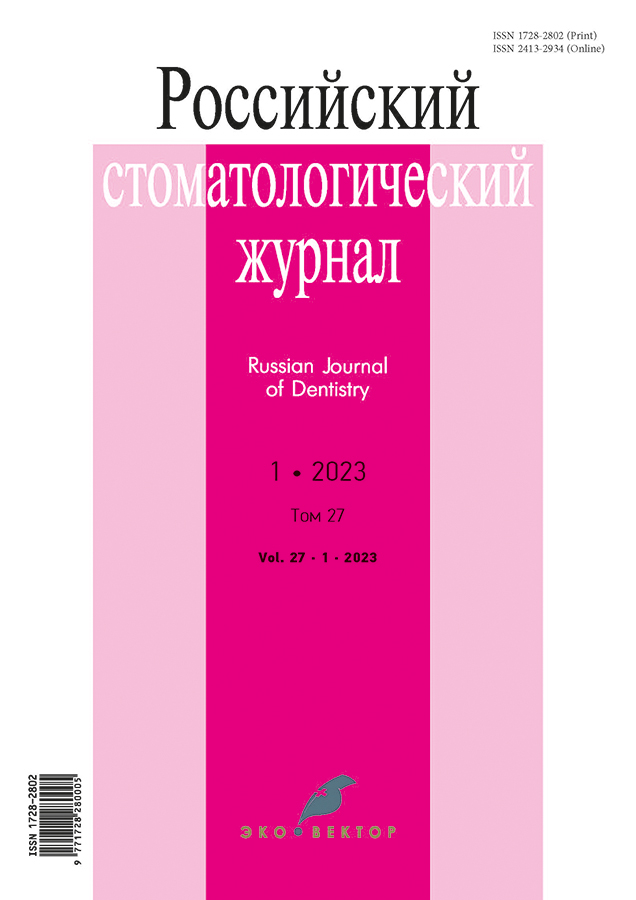Clinical effectiveness of smile design planning
- 作者: Zolotarev N.N.1, Apresyan S.V.1, Stepanov A.G.1
-
隶属关系:
- RUDN University
- 期: 卷 27, 编号 1 (2023)
- 页面: 33-40
- 栏目: Clinical Investigation
- ##submission.dateSubmitted##: 09.01.2023
- ##submission.dateAccepted##: 16.01.2023
- ##submission.datePublished##: 19.06.2023
- URL: https://rjdentistry.com/1728-2802/article/view/121328
- DOI: https://doi.org/10.17816/dent121328
- ID: 121328
如何引用文章
详细
BACKGROUND: Current digital technologies have huge effects on all branches of medicine, including dentistry. Digital smile design allows the creation of prosthetic restorations that are both esthetically and functionally reliable. This study reveals a technique for combining two-dimensional (2D) smile design planning with three-dimensional (3D) planning and evaluating its clinical effectiveness.
AIM: To study patient satisfaction with the virtual smile design dental service provided with and without the 2D planning stage.
MATERIALS AND METHODS: In this study, a mockup was traditionally made (obtaining impressions from the upper and lower jaws, making a wax model of teeth by a technician from a photograph of a patient without a 2D planning stage) using 2D virtual smile design planning. The total sample size was 60 people aged 25–35 years, of which 20 were men and 40 were women. Clinical efficacy was assessed by questionnaire using the OHIP-14 questionnaire before and after planning. The answer options for each question were interpreted as “almost never”, 1 point; “sometimes”, 2 points; “often”, 3 points; and “very often”, 4 points. The scores were inversely correlated. In the first stage, a survey of patients was conducted before planning. Thirty patients underwent traditional mockup, and the remaining 30 patients underwent virtual 2D planning.
RESULTS: The quality of life increased by 1.95 times when using traditional mockup manufacturing technology and 2.8 times using 2D virtual planning. This correlation showed that when using traditional 2D smile design planning, the patient cannot see the stages of dentition modeling, and the technician may not take into account all the wishes of the patient. With virtual planning, the patient is involved in this process. Digital smile simulation allows the demonstration of planning, takes into account the wishes of the patient, increases the trust between the doctor and the patient, and thus achieves a successful planning result.
CONCLUSION: The obtained results show the high clinical efficiency of virtual smile design planning using the developed protocol.
全文:
作者简介
Nikolay Zolotarev
RUDN University
编辑信件的主要联系方式.
Email: nicko31@mail.ru
ORCID iD: 0000-0001-9160-5731
SPIN 代码: 7879-8097
Postgraduate Student, Assistant
俄罗斯联邦, 6 Miklukho-Maklay street, 1171898 MoscowSamvel Apresyan
RUDN University
Email: dr.apresyan@gmail.com
ORCID iD: 0000-0002-3281-707X
SPIN 代码: 6317-9002
Scopus 作者 ID: 741742
MD, Dr. Sci. (Med.), Professor
俄罗斯联邦, 6 Miklukho-Maklay street, 1171898 MoscowAlexander Stepanov
RUDN University
Email: stepanovmd@list.ru
ORCID iD: 0000-0002-6543-0998
SPIN 代码: 5848-6077
Scopus 作者 ID: 737926
MD, Dr. Sci. (Med.), Professor
俄罗斯联邦, 6 Miklukho-Maklay street, 1171898 Moscow参考
- Cervino G, Fiorillo L, Arzukanyan AV, et al. Dental restorative digital workflow: digital smile design from aesthetic to function. Dentistry journal. 2019;7(2):30. doi: 10.3390/dj7020030
- Coachman C, Paravina RD. Digitally enhanced esthetic dentistry-From treatment planning to quality control. J Esthet Restor Dent. 2016;(28):S3-S4. doi: 10.1111/jerd.12205
- Cheng JHC, Luechapanichkul MJ, Lee TYH. The relationship between dentofacial morphology and smile characteristics in lateral and oblique views. Journal of Dental Sciences. 2021;16(1):37–44. doi: 10.1016/j.jds.2020.07.010
- Coachman C, Calamita M, Ricci A. Digital smile design: a digital tool for esthetic evaluation, team communication, and patient management. Ronald E. Goldstein’s Esthetics in Dentistry. 2018:84–111. doi: 10.1002/9781119272946.ch4
- Apresyan SV. Digital planning of orthopedic dental treatment. Russian Journal of Dentistry. 2019;23(3–4):158-164. (In Russ). doi: 10.18821/1728-2802-2019-23-3-4-158-164
- Lebedenko IYu. Peregudov AB. Kompleksnyi podkhod k restavratsii ulybki. Maestro stomatologii. 2000;(3):28–33. (In Russ).
- Ryakhovsky AN, Stepanov AG, Apresyan SV, Zolotarev NN. Combined use of 2D- and 3D-simulation results for identical smile prototype production (clinical case). Clinical dentistry. 2021;24(4):92–95. (In Russ). doi: 10.37988/1811-153X_2021_4_92
- Zolotarev NN, Apresyan SV, Stepanov AG. 2D modeling of smile design for orthopedic rehabilitation of patients. Russian Journal of Dentistry. 2021;25(3):217–223. (In Russ). doi: 10.17816/1728-2802-2021-25-3-217-223
- Apresyan SV, Suonio VK, Stepanov AG, Kovalskaya TV. Evaluation of functional potential of CAD-programs in integrateddigital planning of dental treatment. Russian Journal of Dentistry. 2020;24(3):131–134. (In Russ). doi: 10.17816/1728-2802-2020-24-3-131-134
- Apresyan SV, Stepanov AG, Vardanyan BA. Digital protocol for comprehensive planning of dental treatment. clinical case analysis. Stomatologiya. 2021;100(3):65–71. (In Russ). doi: 10.17116/stomat202110003165
- Apresyan SV, Stepanov AG, Retinskaya MV, Suonio VK. Development of complex of digital planning of dental treatmentand assessment of its clinical effectiveness. Russian Journal of Dentistry. 2020;24(3):135–140. (In Russ). doi: 10.17816/1728-2802-2020-24-3-135-140
- Apresyan SV, Stepanov AG, Antonik MM, et al. Comprehensive digital planning of dental treatment: a practical guide. Moscow: Mozartika; 2020. 398 p. (In Russ).
补充文件






